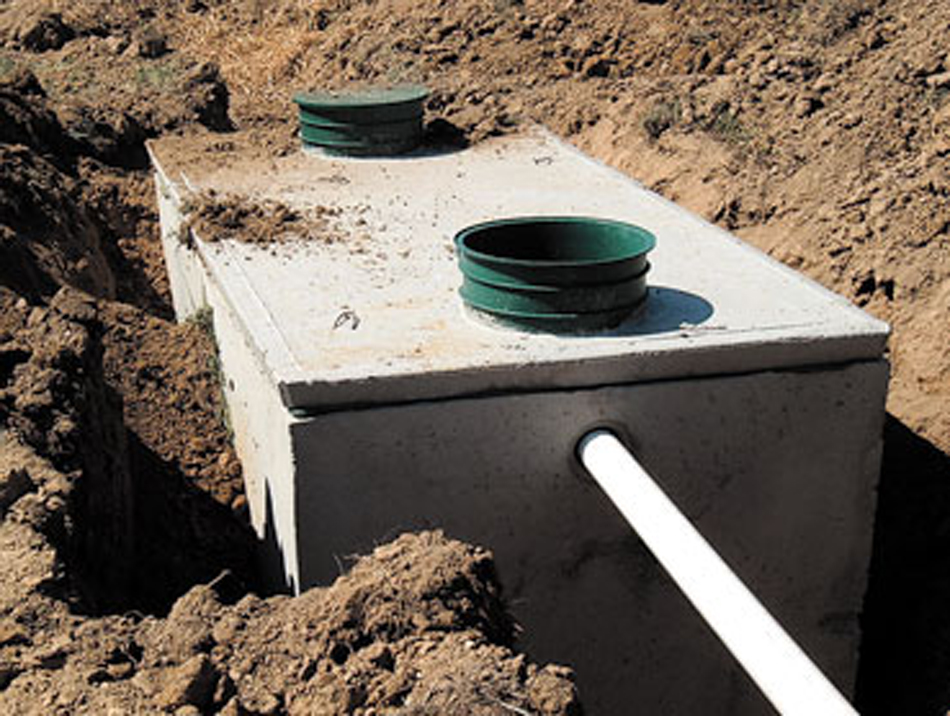Your septic system is an essential, often overlooked, part of your Northern Virginia home. At its core is the septic tank, the first step in wastewater treatment. Knowing what a septic tank is, its types, materials, and expected lifespan is key to proper maintenance and ensuring your home’s waste management system runs smoothly for decades. At Great Falls Septic Service, we’re here to help you understand your septic system better.
What is a Septic Tank?
A septic tank is a watertight container, usually buried underground, that treats household wastewater. It’s essentially a mini on-site sewage treatment plant for homes not connected to a municipal sewer system. Wastewater flows from your home’s plumbing into the tank, where a natural process begins:
- Separation: Heavier solids settle to the bottom, forming a layer of “sludge.” Lighter materials like oils, greases, and fats float to the top, forming a “scum” layer.
- Partial Treatment: In the middle layer, called the effluent, anaerobic bacteria naturally break down some of the organic matter.
- Discharge: The partially treated liquid effluent then flows out of the tank into the drain field (also known as a leach field or absorption field) for further purification by the soil.
Differences Between Concrete, Plastic, and Fiberglass Septic Tanks
Septic tanks are typically constructed from one of three primary materials, each with its own characteristics and considerations for Northern Virginia homes:
1. Concrete Septic Tanks:
- Pros: Extremely strong, durable, and heavy, which makes them less prone to floating in saturated soil. They are widely used in Virginia and offer excellent structural integrity and a long lifespan.
- Cons: Their weight makes installation more complex and requires specialized heavy equipment. While durable, they can be susceptible to cracking over many decades or if subjected to extreme ground movement. Concrete can also be corroded over time by hydrogen sulfide gas.
2. Plastic (Polyethylene) Septic Tanks:
- Pros: Lightweight, making them easier and less expensive to transport and install, especially in challenging terrain common in some parts of Northern Virginia. They are corrosion-resistant and often come with built-in baffles.
- Cons: Their lighter weight means they are more susceptible to floating (especially if empty in high groundwater) if not properly anchored during installation. They can also be more prone to cracking or damage from ground pressure if not properly backfilled.
3. Fiberglass Septic Tanks:
- Pros: Lightweight and highly resistant to corrosion, similar to plastic tanks. Easy to install.
- Cons: Can be more brittle than concrete and may crack if not handled carefully during installation. Like plastic, they require proper anchoring to prevent flotation in areas with high water tables.
Expected Lifespan of Various Septic System Components
The lifespan of your septic system isn’t just about the tank; it involves several components working together. Regular maintenance is the most significant factor in extending these lifespans, regardless of the material.
- Septic Tank:
- Concrete Tanks: Can last 40-50 years or even longer with proper maintenance.
- Plastic/Fiberglass Tanks: Typically last 20-30 years, though some can exceed this with ideal conditions and care.
- Drain Field (Leach Field): This is often the most vulnerable and expensive part of the system.
- The lifespan of a drain field varies greatly depending on soil type, design, usage, and maintenance. On average, a well-maintained drain field in Virginia can last 20-30 years.
- Factors that shorten its life include hydraulic overload, improper waste disposal (grease, chemicals), soil compaction, and root intrusion.
- Pumps (for pumped systems):
- Septic pumps (used in elevated mound systems or those needing to move effluent uphill) typically last 5-15 years, depending on quality, usage, and maintenance.
- Baffles and Filters:
- Baffles: Can last as long as the tank, but can deteriorate or break.
- Effluent Filters: Designed to be maintained (cleaned) regularly and replaced only if damaged. They can last many years if properly cared for.
Anaerobic vs. Aerobic Septic Systems Explained
While most traditional septic systems in Virginia are anaerobic, some properties, especially those with challenging soil conditions or smaller lots, might utilize aerobic systems.
- Anaerobic Septic Systems (Conventional):
- These are the most common type. They rely on bacteria that thrive in oxygen-free environments (anaerobic bacteria) to break down waste inside the septic tank.
- The effluent then flows to a drain field where further natural treatment occurs in the soil.
- They are passive and typically require less electricity (unless a pump is involved).
- Aerobic Septic Systems:
- These systems introduce oxygen into the septic tank (usually via an air pump), promoting the growth of aerobic bacteria, which are more efficient at breaking down waste.
- The treated effluent is much cleaner and can sometimes be discharged to surface waters (with proper permits) or a smaller drain field.
- They require more maintenance, electricity, and often have alarms and a visible treatment unit. They are often used in Virginia where soil types are less suitable for conventional systems.
Your Partner in Septic System Longevity
Understanding your septic tank and system is the first step. Regular inspections and pumping by one of the qualified professionals at Great Falls Septic Service is key to achieving the maximum lifespan for all components of your septic system.


